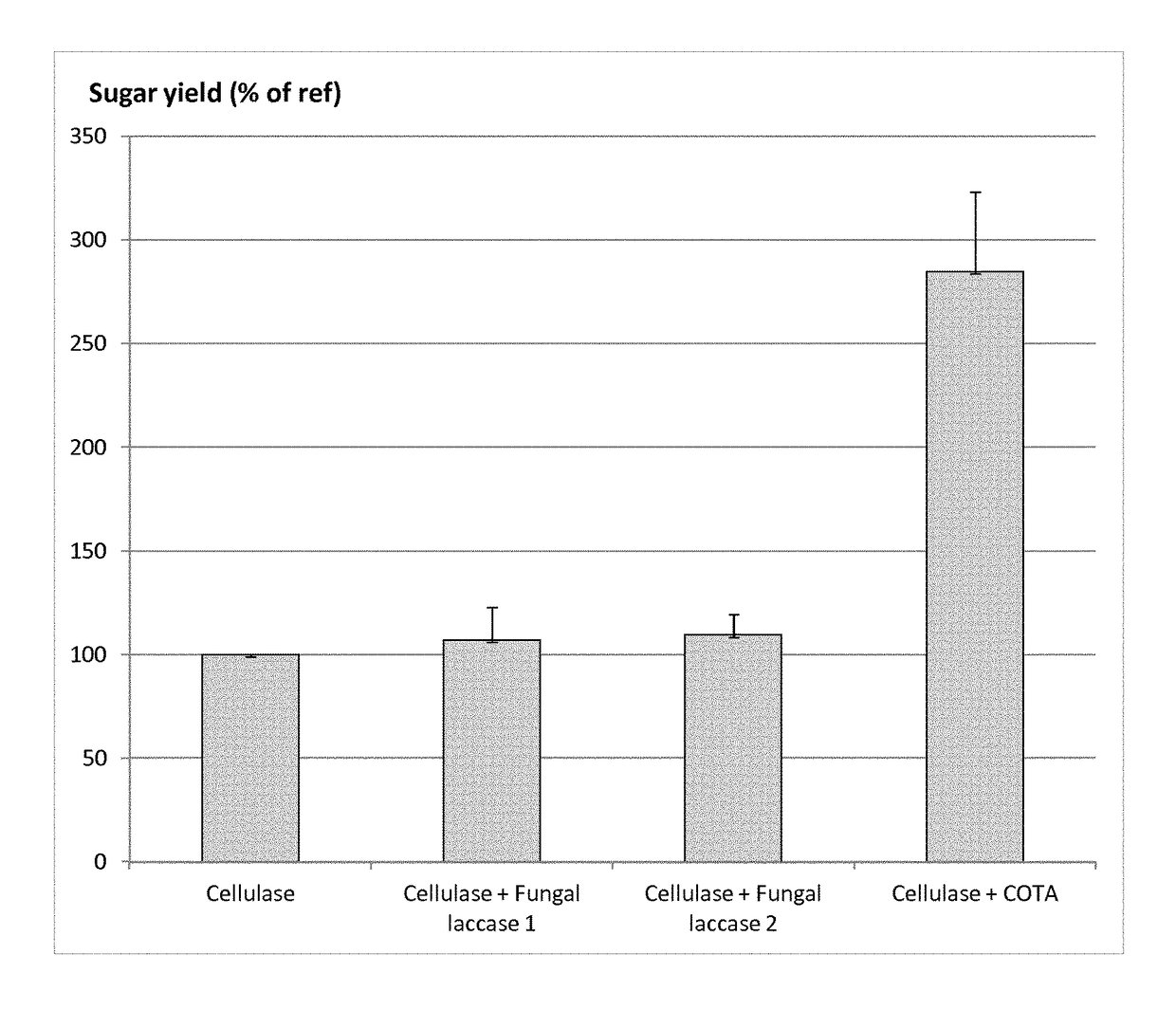Method for improving the fermentable sugar yield from lignocellulosic
a technology of lignocellulosic and fermentable sugar, which is applied in the direction of saccharide production, biochemistry apparatus and processes, enzymes, etc., can solve the problems of reducing the yield of lignocellulosic enzymatic digestion, etc., to achieve the effect of improving the yield of lignocellulos
- Summary
- Abstract
- Description
- Claims
- Application Information
AI Technical Summary
Benefits of technology
Problems solved by technology
Method used
Image
Examples
example 1
Effect of Different Laccases on Sugar Yield from Enzymatic Hydrolysis of a Lignocellulosic Substrate
[0040]Pieces of old corrugated cardboard were subjected to enzymatic hydrolysis. We carried out parallel experiments where hydrolysis of cellulose was performed in the absence of laccase or in the presence of one of the three laccases: (1) Spore coat protein from Bacillus subtilis CotA (COT2 (SEQ ID NO:2, recombinantly expressed in E. coli), (2) commercially available fungal laccase from white-rot-fungi Trametes versicolor (available from Sigma-Aldrich), and (3) laccase from white-rot-fungi Pleurotus ostreatus recombinantly expressed in Yeast Saccharomyces cerevisiae (Piscitelli, A., Giardina, P., Mazzoni, C., & Sannia, G. (2005). Recombinant expression of Pleurotus ostreatus laccases in Kluyveromyces lactis and Saccharomyces cerevisiae. Applied microbiology and biotechnology, 69(4), 428-39. doi:10.1007 / s00253-005-0004-z).
[0041]Pieces of old corrugated cardboard were pre-treated with ...
example 2
Enzymatic Hydrolysis of Various Lignocellulosic Feedstocks
[0046]Enzymatic hydrolysis of various lignocellulosic feedstocks was carried out in order to evaluate the effect of CotA laccase treatment on sugar yield (Table 1).
[0047]The following ligno-cellulosic substrates were used:
[0048]Steam exploded wheet straw: steam explosion was performed in a steam explosion instrument at 200 degrees Celsius for 2.5 min, the slurry after steam explosion was washed with water and dried. Old corrugated cardboard was treated with 0.5% NaOH at 15% consistency for 1 h at 90 degrees Celsius, then the material was washed with water and dried. Eucalyptus pulp is pulp (wood fibers) obtained by chemical pulping (kraft pulping) and collected after bleaching step. It is practically pure cellulose fibers with small traces of lignin. Blow pulp Soft wood (Spruce) and Blow pulp, Hard wood (birch) are pulps (wood fibers) obtained by chemical pulping (kraft pulping) collected before bleaching step from the Blow t...
PUM
| Property | Measurement | Unit |
|---|---|---|
| period of time | aaaaa | aaaaa |
| time | aaaaa | aaaaa |
| time | aaaaa | aaaaa |
Abstract
Description
Claims
Application Information
 Login to View More
Login to View More - R&D
- Intellectual Property
- Life Sciences
- Materials
- Tech Scout
- Unparalleled Data Quality
- Higher Quality Content
- 60% Fewer Hallucinations
Browse by: Latest US Patents, China's latest patents, Technical Efficacy Thesaurus, Application Domain, Technology Topic, Popular Technical Reports.
© 2025 PatSnap. All rights reserved.Legal|Privacy policy|Modern Slavery Act Transparency Statement|Sitemap|About US| Contact US: help@patsnap.com

